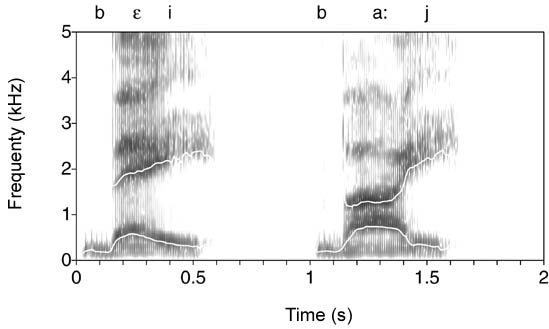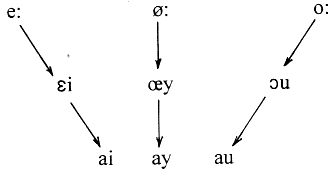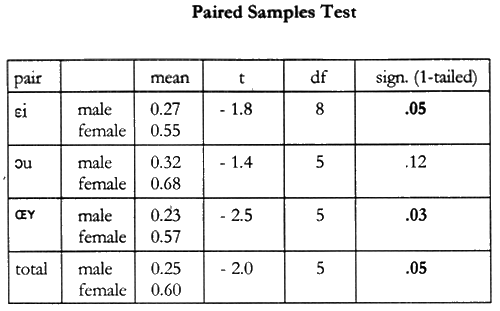
| Stroop, Jan, 'Young Women’s Farewell to Standard
Dutch' : Paper Conference on Methods in Dialectology,
1-6 August 1999, St. John’s, Newfoundland, Canada
Jan Stroop |
|||||||||||||||||||||||||||||||||||||||||||||||||||||||||||||||||||||||||||||||||||||||||||||||||||||||||||||||||||||||||||||||||||||||||||||||||||||||||||||||||||
|
Young Women’s Farewell to Standard Dutch |
|||||||||||||||||||||||||||||||||||||||||||||||||||||||||||||||||||||||||||||||||||||||||||||||||||||||||||||||||||||||||||||||||||||||||||||||||||||||||||||||||||
| (In the text I have to use SAMPA
for phonetic transcription, in the figures I use the IPA notation)
In almost all of the Germanic languages and dialects that I know,
the original Westgermanic long monophthongs î and û
have developed into low diphthongs, i.e. /ai/ and /au/. This is
the development you can find in most books about the history of
English and German. The mid diphthongs [Ei] and [9y] are often not
even mentioned. Nevertheless, there is no doubt that there has been
an intermediate stage of [Ei] and [9y] in both languages, even though
this situation did not last very long. [Ei] and [9y] have always
proved to be very unstable. These facts are not really very surprising, because lowering of diphthongs is a very natural development, in languages all over the world (Labov 1994). Therefore, it is rather remarkable that the official Dutch pronunciation, the so-called ABN standard, still has the mid-diphthongs [Ei] and [9y]. There is a Dutch proverb which is ascribed to the famous German poet Heinrich Heine. It goes as follows: when our planet Earth will come to an end, better go to the Netherlands because there everything happens 50 years later than anywhere else. It seems that Heine is not really the author of this proverb, but in phonology the saying itself seems to be true, more than true. In ABN-Dutch the Great Vowel Shift has started not just fifty but more than three hundred years later than elsewhere, that is, it is taking place now. And so we can witness a very comprehensive vowel shift taking place right in front of our eyes (or rather ears), simply by listening to the Dutch radio and tv stations. I give some examples. First I discuss a few mid diphthongs of ABN-Dutch. Concerning the abbreviation ABN, this stands for ‘Algemeen Beschaafd Nederlands’, in English: General Civilized Dutch. The name is comparable more or less with RP in English: a pronunciation which gives little or no clue to a speaker’s regional affiliation (O’Connor 1973, 128). Sound sample nr. 1 concerns some fragments of ABN-Dutch;
Some indications about the profession of the speakers: The first speaker is a professor in Dutch linguistics. The second is a highly competent presentator of tv and radio programs. Both of them are speaking ABN-Dutch as can be heard from their ij sounds. Sound sample nr. 2 concerns some fragments of Dutch with lowered diphthongs, especially with lowered ij.
As can be heard the realization of ij by the last three speakers comes very near to English and German aai: Compare, for example, the pronunciation of the Dutch preposition bij [ba.i] in the fragments you heard last, with English by. And the vowel in raai from the last speaker is very similar to that of English right. The differences between those two phonemes have to do with articulation. The [Ei] requires a more closed mouth, or a higher jaw. The /ai/ requires a lower jaw.
But also the acoustic features of both phonemes considerable, as can be seen in figure nr. 3. The pictures show the frequencies of the two most important formants of the vowels; on the left picture, that of the formants of the word bij,two black strips in the lower part, immediately after the b, show that the two frequencies of ei are not stable but are changing and separating, during the whole performance of the diphthong. That means that at any point of the performance the ei sounds the same. Phoneticians call these type of diphthong an ‘essential’ diphthong; the same is the case with two other Dutch diphthongs, the [9y]in huis and [Au] in koud; they have the same kind of features as the [Ei]. The shape of the formants of the aai of baai, which means ‘baye’, in the right picture, is totally different. Here we see after the b that the two strips are parallel, during the performance of the aa; they separate out only after the aa, when the half-vowel j begins. So it is clear that the aai in baai is a completely different sound from the [Ei]; in fact it is a combination of aa and j, a sequence of two vowels. When we drop the last part, there is no diphthong at all. The lowered [Ei] in Polder-Dutch is supposed to have the same type of features as this aai. There are two main causes, in my opinion, which can explain why the mid diphthongs in many languages are lowered very quickly. Both causes are of an internal type. First of all, consider the situation from the point of the speaker. As phoneticians have pointed out, low diphthongs are easier to articulate because they don’t need a very accurate articulation: you open your mouth and the aai and aau are there, so to speak. But not such with the ABN-diphthongs. For non-native speakers, who are learning to speak Dutch, they are the most difficult Dutch vowels. Normally they are the last traces, from which you may detect that a speaker is a non-native one. From the point of view of the listener, there is also an internal reason to prefer low diphthongs: a low diphthong is louder, because the mouth is wide open, so you can hear it better. It is because of that I think that the most lowered diphthongs are produced by singers of Dutch songs. Both factors, which favour lowered diphthongs, make it highly remarkable that ABN has preserved its mid diphthongs for such a long time. There must have been a very strong factor behind this. And there was. In the same period that the vowel shift took place in English and German, and also in the dialects of the Dutch provinces of North and South Holland (the 16th century) there was a movement in the Netherlands to create and establish a language which could function as a nationwide language for the time when the Dutch Republic should become independent. A number of writers, linguists, teachers and other prominents were engaged in selecting and cultivating elements for the national language (the later ABN). Those elements were mainly taken from the dialects and the language of educated people in the provinces of Holland. With respect to the diphthongs, there was an almost general opinion that the diphthongs as they were spoken in the rural dialects of Holland, especially aai, were not acceptable: they sounded too awful. Therefore all teachers, writers and other important citizens decided to stick to [Ei] and [9y]. So strong was the influence of the teachers and so great the prestige of the language they had created (or the respect for the people who spoke that language), that the mid diphthongs, ei, ui and ou, could survive and almost remained unchanged for centuries. This situation continued until the sixties and seventies of this century. In this period society changed in a radical way, as was the case in most of the western societies. Rules and traditions were falling away. The stronger the old rules the stronger the reaction against them. Also the ABN standard, which is - as I said earlier - the pronunciation of Dutch which was taught at school and was the spoken standard, began to lose its prestige and functioned no longer as a model. So at last it became possible for the three essential diphthongs to be lowered. Not the lowering itself is surprising, because it is a natural change, but it is that long delay of more than three centuries that is remarkable.
The lowering of the ABN diphthongs is very similar to the Great Vowel Shift in English, as can be seen in figure 4. Like the G.V.S., it is a complex of different chain-movements. In the left part of the vowel-triangle, that is the front part of the human mouth the diphthong /e/ is being lowered and reaching the position of /ai/. The place of the original[Ei] is being filled up by the lowering and diphthongization of the long monophthong /e./. The same happens with the two others diphthongs, [9y] and [Au]. Lowering of the [9y] makes room for the [ø] to be lowered in turn; lowering of the [Au], gives the opportunity for [o.] to do the same. When you are listening to Dutch speech the change of the [Ei] is especially striking, more than that of the two other diphthongs. There are two reasons for this. First of all, the diphthong [Ei] is much more frequent than the other two. Secondly, the change of [Ei] is more radical, with regard to its acoustic properties. There are very clear indications that the change of the diphthongs has taken place earlier and has been more drastic than that of the long monophthongs above them. It, therefore, seems correct to assume that the change is a drag-change, but further research has to be done on this point. And again, not the change itself is exceptional, but rather the extremely long delay. There is yet another surprising aspect. It is a well-known fact in sociolinguistics that in most situations women speak a variety of language that is nearer to the standard than men do. Women are more aware of the social significance of linguistic variables than men. In the Netherlands this situation obtained too, as is pointed out in several investigations. Now, however, a complete different development seems to be in progress. The first group of speakers for which the lowered diphthongs were noticed, were high middle class women aged between thirty and forty. These are writers, scientists, politicians, film directors, professors and so on. They live all over the Netherlands. They are ambitious and intend to make a career or have already made one. A number of them have declared themselfs feminists. No men in a comparable group have been observed to have the same lowered diphthongs. For the first time then we are confronted with a language change which is moving away from the ABN standard, and which started with well-educated women in the seventies. Since Polder-Dutch is spreading among the whole population, step by step, the younger the generation the more they speak Polder-Dutch. Among children younger than ten, male and female, the lowered diphthongs are the norm. Parents who speak ABN themselves are very concerned when they hear their children speak in such a way. But all their efforts to change their childrens aai’s in ei’s are useless. For those parents this is painful because in the Netherlands these lowered Dutch sounds has the same effect on ABN-speakers as you perhaps would experience if you heard Queen Elisabeth speak Cockney English, for example, while in Heathrow asking for gaait number foif (‘Gate number 5'). Of course there is a lot of investigation to do, because a number of aspects are involved, such as the history of the feminist movement in the Netherlands. Also the phonetic and phonological aspects have to be considered. Perhaps there is also a kind of lexical diffusion. An investigation in real time will be set up. That seems possible because many of these women have spoken on radio in the past and their speeches and interviews have been taped and been preserved. Also a classical sociolinguistic investigation will be carried out, with recordings of different styles of speech, casual, formal, word lists and so on, to find out if this really is a change in progress. It would also be very interesting to investigate whether the lowering of the diphthongs is a linguistic change from above, which I believe, or from below. The first small steps have already been taken and I am in a position to show some results. They represent our first attempt to try to confirm our observations that well-educated women use lower diphthongs than educated men do. We made recordings from a well-known sophisticated tv-program on the 3d channel, which is called The Blue Light. In this program four people critically discuss recent tv-programs. Two members of the panel change every time, the so-called guests. In last year’s season it so happened that each time these guests were a man and a woman, all of higher middle class. One of the students of Dr. Renée van Bezooijen, from the University of Nijmegen, Mrs. Edelman, has transcribed the first 15 realizations of the three diphthongs of each of the in total 12 guests. This number is supplemented with, as far as the first diphthong is concerned, 3 men and 3 women from a radio news program. So in total we tested 18 speakers: 9 women and 9 men.
The realizations are indexed in 4 steps, as you can see at the bottom of figure number 5. When a diphthong has the same quality as in ABN, it receives a 0, the most lowered aai receives a 3; the two steps in-between are indexed as 1 and 2. After the name of each speaker his or her mean scores per diphthong are presented; in column number 4 the mean of their three diphthongs. The higher the score the lower the diphthong. From a first glance at column 4 one may conclude that in most cases (but not always) in each pair, the woman has the highest scores, which means the lowest diphthongs. Remarkable are the scores for Roberta Alexander. She is a famous American classical singer, but she has lived in the Netherlands for years. She speaks Dutch very well, although with an unmistakable American accent. Nevertheless her diphthongs are not as low as those of two Dutch native-speakers, Dana Nechustan and Annemarie Mol. On this point Roberta Alexander speaks more ABN-like than the two Dutch women. But because she is not a native speaker we have left her scores aside.
To test the significance of the differences in the mean values for the three variables and for the total values we used a t-test for paired samples. For [Ei] the test was based on 9 paired values, for [9y], [Au] and /total/ on 6 paired values. The results have been presented in figure nr. 6.A 1-tailed test was used because our hypothesis was one-directional: we hypothesized that the female speakers would have higher values than the male speakers. It can be seen that the values for [Ei] and /total/ are significant at the 5% level, for [9y] even at 3% level, with the means in the expected direction: we indeed find higher values, i.e. lower realizations, for the female speakers. So this means that we can maintain our hypothesis. Of course, we will continue our investigations with greater samples and samples of a different kind. But for the moment we may conclude that higher middle class women use lower diphthongs than men from the same class. In other words, Netherlandic higher middle class women take the lead in speaking a variation of Dutch which is moving away from ABN-Dutch. This is in full contrast with the situation in previous generations. There we saw that lower class men were moving away from the standard norm. So the development of modern Dutch is in double contrast with that of the older situation: women of the higher middle class are now playing the same role as men of the lower class in the past. But why is it the only women from this class do this? Of course it is linked with the position of women in our society. Women, who in the past showed awareness of the social significance of linguistic variables, now are the first to see that in our egalitarian society language functions no longer as such. Besides, the women who are using these lowered diphthongs, have good jobs and important positions; they profit the most from the new economic and social situation. And therefore they don’t need language to acquire status. This can explain their linguistic behaviour. The moment that rules and traditions, including those concerning pronunciation, are undermined or thrown away, the groups which have respected those rules the most, are inclined to react in a more extreme way than others. Generally, the greater the repression the more extreme the reaction, when the repression has gone. A second important factor is the feminist attitude among a number of those women, which is responsible for their increasing self-awareness. I have called this lowered variety of Dutch Poldernederlands, which in translation is something like Polder-Dutch, for the following reason. ‘Polder’ is loaned from the composition ‘poldermodel’, a popular name for the recent economic model of the Netherlands, a model that is based on consensus of all parties. Everyone knows that this poldermodel has brought a great deal of welfare to our country. But in the meantime this economic success is changing our society in a less positive way in some respects. It has also strengthened the social results of the sixties and seventies. One of these results is Poldernederlands. As you understand it is also a kind of tongue-in-cheek-name. Finally we may conclude that Heinrich Heine or his ghostwriter has been only partly right: in the Netherlands the lowering of the mid diphthongs indeed happens very much later than anywhere else, but on the other hand Dutch society has token a lead in becoming an advanced egalitarian society, which allows well-educated women of the higher middle class to say ‘Farewell to linguistic variables-with-former-prestige’.
Literature: Brouwer, D. Labov, W. O’Connor, J.D., Article published on the WWW: October 1999 j.stroop@hum.uva.nl |
|||||||||||||||||||||||||||||||||||||||||||||||||||||||||||||||||||||||||||||||||||||||||||||||||||||||||||||||||||||||||||||||||||||||||||||||||||||||||||||||||||



